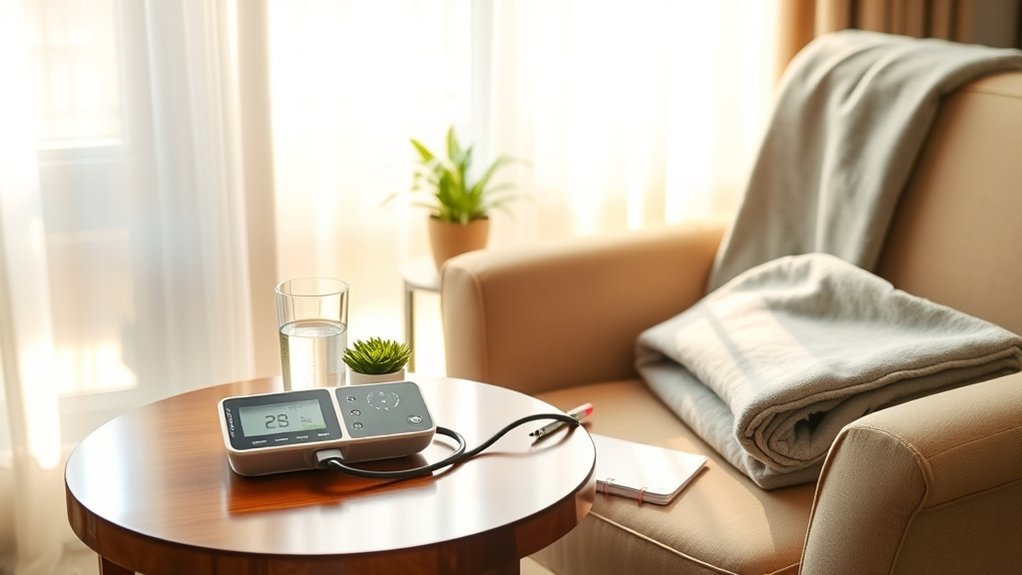Home blood pressure monitoring is vital for your health, especially if you’re at risk of hypertension. By regularly tracking your numbers, you can catch any concerning trends early on. But how do you get the most accurate readings? It starts with choosing the right monitor and establishing a routine. Plus, making lifestyle changes can greatly impact your blood pressure. Let’s explore these essential steps to keep your cardiovascular health in check.
Understanding Blood Pressure Readings
Understanding blood pressure readings is essential for managing your health effectively.
Blood pressure is measured in millimeters of mercury (mm Hg) and consists of two numbers: systolic and diastolic. The systolic number, the higher value, indicates the pressure in your arteries when your heart beats. The diastolic number, the lower value, reflects the pressure when your heart rests between beats.
Blood pressure readings consist of two key numbers: systolic, measuring heartbeats, and diastolic, indicating heart rest.
A normal reading is typically around 120/80 mm Hg. Readings above this range can indicate hypertension, while lower readings may signal hypotension.
Regularly monitoring your blood pressure helps you identify trends and detect potential issues early. Always consult your healthcare provider to understand what your readings mean and how to manage any concerns effectively.
Choosing the Right Blood Pressure Monitor
When it comes to managing your blood pressure at home, choosing the right monitor is essential for obtaining accurate readings.
Look for an automatic, cuff-style monitor that fits your arm comfortably. Wrist monitors can be less reliable, so it’s best to avoid those unless necessary.
Check for features like large displays, memory storage for previous readings, and a heart rate monitor for added insight. Confirm the device is validated for accuracy by a recognized medical organization.
Before purchasing, read reviews and consult your healthcare provider for recommendations.
Finally, choose a monitor with a warranty, so you can have peace of mind. Making the right choice confirms you’ll stay informed about your health effectively.
Establishing a Consistent Monitoring Routine
To effectively manage your blood pressure, establishing a consistent monitoring routine is essential. Regular readings help you identify trends and detect potential issues early. Here’s how to create your routine:
| Tip | Action |
|---|---|
| Choose a time | Pick a specific time each day |
| Set reminders | Use alarms or calendar alerts |
| Keep a log | Document your readings consistently |
| Stay calm | Relax for a few minutes before measuring |
| Review results | Check your log weekly for patterns |
Lifestyle Changes for Healthy Blood Pressure
Monitoring your blood pressure at home is just the first step in managing your health. To maintain healthy blood pressure, consider making some lifestyle changes.
Start by eating a balanced diet rich in fruits, vegetables, whole grains, and lean proteins while reducing salt intake. Regular physical activity, like brisk walking or cycling, can also help lower your blood pressure. Aim for at least 150 minutes of moderate exercise each week.
Eating a balanced diet and engaging in regular physical activity are key steps to lower blood pressure effectively.
Additionally, managing stress through relaxation techniques, such as yoga or meditation, can be beneficial. Limit alcohol consumption and quit smoking if you haven’t already.
Finally, getting enough sleep each night plays an essential role in keeping your blood pressure in check. Malnutrition poses significant threats to overall health, so small changes can lead to significant improvements in your overall health.
When to Consult a Healthcare Professional
If you notice consistent readings above the normal range or experience symptoms like headaches, dizziness, or shortness of breath, it’s essential to consult a healthcare professional.
Monitoring your blood pressure at home is important, but there are specific situations where expert guidance is imperative. Consider seeking help if you:
- Have three or more consecutive high readings.
- Experience severe headaches or vision changes.
- Notice swelling in your legs or feet.
- Feel unusually fatigued or weak.
Don’t wait for symptoms to worsen. Early intervention can prevent complications and improve your overall health. Additionally, be aware of the potential health risks associated with insect-borne diseases, as they can complicate existing health conditions.
Frequently Asked Questions
Can Stress Affect My Blood Pressure Readings at Home?
Yes, stress can affect your blood pressure readings at home. When you’re stressed, your body releases hormones that temporarily raise blood pressure. It’s important to measure your levels when you’re calm for accurate results.
How Often Should I Replace My Blood Pressure Monitor?
You should replace your blood pressure monitor every 2 to 3 years, or sooner if it shows inaccurate readings. Regular calibration and maintenance can help guarantee its accuracy, so keep an eye on its performance.
What Time of Day Is Best for Monitoring Blood Pressure?
The best time for monitoring blood pressure is in the morning, ideally before you eat or take medications. This guarantees consistency and helps you track your levels accurately throughout the day.
Should I Take Blood Pressure Readings While Standing or Sitting?
Taking blood pressure readings while sitting’s like finding calm in a storm. It’s more reliable than standing, as your body stabilizes. So, settle down, keep your feet flat, and measure for accurate results.
Can Medications Influence My Home Blood Pressure Measurements?
Yes, medications can influence your home blood pressure measurements. Some may lower your readings, while others might raise them. It’s crucial to monitor your blood pressure regularly and consult your doctor about any changes.
Conclusion
By taking charge of your home blood pressure monitoring, you can play an essential role in managing your cardiovascular health. Remember to choose the right monitor, stick to a routine, and make lifestyle changes that support healthy blood pressure levels. After all, wouldn’t you want to catch any potential issues early on? Stay proactive and consult a healthcare professional if your readings raise any concerns. Your heart will thank you for it!
